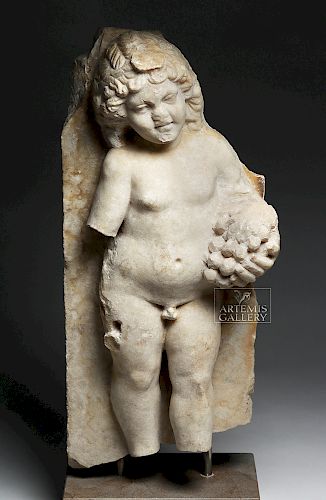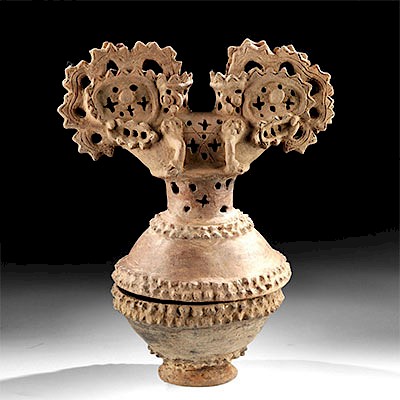Roman Marble Sarcophagus Section - Erote & Grapes
Lot 31b
About Seller
Artemis Gallery
686 S Taylor Ave, Ste 106
Louisville, CO 80027
United States
Selling antiquities, ancient and ethnographic art online since 1993, Artemis Gallery specializes in Classical Antiquities (Egyptian, Greek, Roman, Near Eastern), Asian, Pre-Columbian, African / Tribal / Oceanographic art. Our extensive inventory includes pottery, stone, metal, wood, glass and textil...Read more
Categories
Estimate:
$15,000 - $22,500
Absentee vs Live bid
Two ways to bid:
- Leave a max absentee bid and the platform will bid on your behalf up to your maximum bid during the live auction.
- Bid live during the auction and your bids will be submitted real-time to the auctioneer.
Bid Increments
| Price | Bid Increment |
|---|---|
| $0 | $25 |
| $300 | $50 |
| $1,000 | $100 |
| $2,000 | $250 |
| $5,000 | $500 |
| $10,000 | $1,000 |
| $20,000 | $2,500 |
| $50,000 | $5,000 |
| $100,000 | $10,000 |
| $200,000 | $20,000 |
About Auction
By Artemis Gallery
Aug 22, 2019
Set Reminder
2019-08-22 10:00:00
2019-08-22 10:00:00
America/New_York
Bidsquare
Bidsquare : Fine Ancient | Asian | Ethnographic Art
https://www.bidsquare.com/auctions/artemis-gallery/fine-ancient-asian-ethnographic-art-4348
Featuring classical antiquities, ancient and ethnographic art from cultures encompassing the globe, plus fine art. Egyptian, Greek, Roman, Etruscan, Near Eastern, Asian, Pre-Columbian, Native American, African / Tribal, Oceanic, Spanish Colonial, Russian, Fine Art, so much more! Artemis Gallery info@artemisgallery.com
Featuring classical antiquities, ancient and ethnographic art from cultures encompassing the globe, plus fine art. Egyptian, Greek, Roman, Etruscan, Near Eastern, Asian, Pre-Columbian, Native American, African / Tribal, Oceanic, Spanish Colonial, Russian, Fine Art, so much more! Artemis Gallery info@artemisgallery.com
- Lot Description
Roman, Imperial Period, ca. 2nd century CE. Finely carved in extremely high relief - virtually in the round - a section of a marble sarcophagus depicting the god Eros (Roman Cupid) or one of the Erotes (Roman Cupids) holding a large bunch of harvested grapes in his left hand. Eros, depicted as a nude cherub, is posed standing in contrapposto, with his weight shifted to his left leg, one arm angled to carry the fruit of the vine, the other missing its forearm, perhaps once carrying more grapes (a common theme of Hellenistic and Roman art) or his bow. In addition to possessing an impressive understanding of anatomy and an ability to render flesh from stone, the sculptor of this piece was skilled in communicating naturalism in Cupid's facial features - those generously lidded, almond-shaped eyes, apple cheeks, pudgy nose, and full lips - framed by a wavy coiffure adorned by a leafy crown. Size: 10.75" W x 24.5" H (27.3 cm x 62.2 cm); 27.375" H (69.5 cm) on included custom stand.
Eros was the mischievous yet endearing god of love, a minion, constant companion, and according to some classical writers, a son of the goddess Aphrodite. In the Roman period, Eros had become a child (to the earlier Greeks, he was a muscular youth), but here he retains his mischievous air, ready to help couples fall in love through not-entirely-innocent interventions.
In time, ancient poets and artists multiplied Eros into a group of Erotes - winged gods of love or Roman Cupides. Hesiod describes a pair - Eros (Love) and Himeros (Desire) - both present at the birth of Aphrodite. However, later writers added a third Erote named Pothos (Passion). Some depicted twin Erotes - Eros (Love) and Anteros (Love Reciprocated) - who were usually shown gracing the scales of love. Eventually, poets multiplied them to envision an even greater number of winged putti. Indeed, the Erotes were the creations of poetic invention without any distinct mythology of their own - as opposed to Eros, the God of Love.
See a marble sarcophagus fragment depicting Eros - although much smaller and less complete than this example - at the Metropolitan Museum of Art, New York (accession number: 49.101.16) - https://www.metmuseum.org/art/collection/search/254643
Provenance: private East Coast, USA collection; ex-Gorny & Mosch, Germany; ex-European Collection, 1980's
All items legal to buy/sell under U.S. Statute covering cultural patrimony Code 2600, CHAPTER 14, and are guaranteed to be as described or your money back.
A Certificate of Authenticity will accompany all winning bids.
We ship worldwide and handle all shipping in-house for your convenience.
#132442Losses to the left arm, lower legs/feet, high pointed areas such as peripheries of head ornament, grapes, nose, chin, and sections of relief plaque behind.Condition
- Shipping Info
-
All shipping is handled in-house for your convenience. Your invoice from Artemis Gallery will include shipping calculation instructions. If in doubt, please inquire BEFORE bidding for estimated shipping costs for individual items.
-
- Buyer's Premium



 EUR
EUR CAD
CAD AUD
AUD GBP
GBP MXN
MXN HKD
HKD CNY
CNY MYR
MYR SEK
SEK SGD
SGD CHF
CHF THB
THB

















